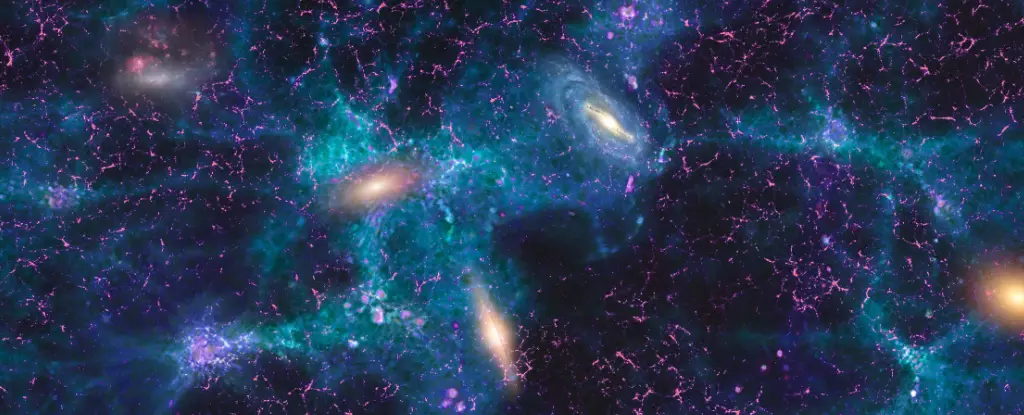The cosmos has long fascinated astronomers, with its vast expanses filled with celestial bodies that challenge our understanding of physics. Recent findings indicate that the universe is expanding at a rate that current scientific frameworks struggle to explain, specifically highlighted by precise measurements from a galaxy cluster situated over 300 million light-years away. This revelation raises substantial questions regarding the existing cosmological models and our fundamental comprehension of the universe’s origins and its ongoing expansion.
The Nature of Cosmic Expansion
For nearly a century, the consensus among cosmologists has been that the universe originated from an intensely compact ball of mass and energy, which gradually expanded into the remarkable assemblage of galaxies we observe today. This process is theorized to have been influenced by a multitude of factors: inflationary quantum fields, a force of gravity that remains perplexingly weak, and a mysterious form of energy dubbed ‘dark energy.’ These elements converge to create an evolving cosmic framework marked by clusters of matter, some visible and some not, all receding from one another at a predictable pace governed by what scientists refer to as the Hubble constant.
However, the studies measuring this constant have presented a conundrum. The data collected through diverse methodologies yield differing results, leading to a phenomenon known as ‘tension’ in cosmology. Dan Scolnic of Duke University has been at the forefront of investigating this phenomenon, labeling it a significant problem, if not a crisis. The inconsistency of results challenges the reliability of established paradigms that have stood for decades, forcing scientists to rethink their assumptions and seek deeper understanding.
Measurement Challenges in Cosmology
To achieve a more precise understanding of the Hubble constant, astronomers depend on meticulous measurements of distant galaxy clusters. A highlight of this endeavor involved examining the Coma galaxy cluster, a dense assembly of over 1,000 galaxies roughly 321 million light-years away. The Dark Energy Spectroscopic Instrument (DESI) provided crucial data that allowed researchers to create a ladder of measurements extending outward into the cosmos. Scolnic emphasizes the importance of this process, referring to the challenge of obtaining accurate distance measurements as finding the “first rung” of a cosmic ladder.
Utilizing spectra of light emitted by supernovae—specifically Type Ia supernovae, which emit light in a consistent manner—Scolnic and his team achieved an improved estimate of the distance to the Coma cluster. This allowed for the derivation of an expansion rate calculated at approximately 76.5 kilometers per second per megaparsec. Remarkably, this figure deviates from another measurement framework based on observations of the Cosmic Microwave Background (CMB)—the ancient light from the universe’s formative moments—that yields a substantially lower expansion rate of 67.4 kilometers per second per megaparsec.
The divergence in these measurements poses one of the most profound questions in modern cosmology. Why do different methodologies yield such contrary results? The potential implications are monumental. Identifying a critical miscalculation could elucidate the observed tension, while alternatively uncovering new physics would necessitate a fundamental paradigm shift in our understanding of the universe. Addressing this discrepancy and refining measurement techniques is essential to advancing the field, as astronomers push the boundaries of experimental limits.
Scolnic contends that current methodologies are being rigorously tested against the evidence available, indicating a significant moment where established models may need reevaluation. The confirmation of these differing expansion rates has incited excitement and concern within the scientific community, propelling researchers to explore advanced solutions and innovative frameworks to bridge these gaps in knowledge.
As we stand on the precipice of potentially groundbreaking revelations, the investigations into the universe’s expansion serve as a reminder of the vibrant, ever-evolving nature of scientific inquiry. Tensions in cosmology not only signify a crisis but also present an opportunity for transformative discoveries that could reshape our understanding of the cosmos. The quest for answers is not merely an academic pursuit; it is a journey to uncover the very fabric of reality.
In essence, the expanding universe remains a mystifying phenomenon intertwined with the fundamental laws of physics, with each new measurement and discovery opening portals to profound questions that fascinate both scientists and enthusiasts alike. The pursuit of knowledge about our universe continues, fueled by curiosity and the relentless spirit of inquiry that defines humankind’s greatest endeavors.

